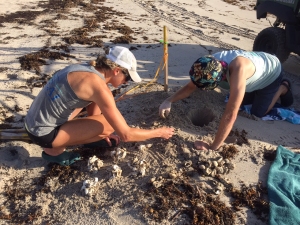Grant: 14-010R
Project Title: Integrating stable isotope analysis and hatchling productivity assessments to infer relative importance of loggerhead foraging areas, Year 2
Project Manager: Simona Ceriani
Organization: University of Central Florida (Research and Educational Institute)
Grant Amount: $39,060.00
Completion Date: 2017-05-02
Summary: Understanding geospatial linkages is critical to the development of appropriate management and conservation strategies for migratory species. Florida hosts the largest rookery in the Western Hemisphere, yet few research groups encounter nesting females at night. In contrast, thousands of nests are marked to assess hatchling production through an extensive nesting survey program. Our sampling design was based on the relative importance of the five geographic areas used in the FWRI sampling scheme and reflected temporal distribution across the entire loggerhead nesting season. Loggerheads using different foraging grounds experience different environmental conditions and resource availability that may affect the number of years between reproductive seasons. Considering the known variability in remigration interval, it is necessary to undertake a multi-year study, if we aim to understand relative importance of foraging grounds for the Florida nesting aggregation. This project is the second year and includes an additional biomarker in order to better discriminate among isotopic signatures of foraging areas previously identified by satellite telemetry. We will use the previously-developed assignment model based on satellite-tracked nesting loggerheads to assign foraging areas used by untracked turtles and determine the relative contribution of the different foraging grounds to the Florida loggerhead nesting population. Using a non-destructive sampling method (unhatched non-viable eggs), we will provide a comprehensive geographic assessment of foraging grounds used by loggerheads nesting in Florida in a given year, how foraging ground contributions change between years and shed light on the relative importance of foraging areas at the population level. As resources are limited, there is a need to prioritize where funds should be spent in order to maximize conservation benefits from management activities. Understanding relative importance of foraging grounds will allow us to make more informed management decisions by focusing mitigation and by-catch reduction measures on areas that represent loggerhead hotspots. Results: This study represents the first comprehensive geographic assessment of foraging areas use by loggerhead nesting in Florida. The results of the assignment model were congruent with previous satellite telemetry conducted in Florida (e.g., Girard et al. 2009, Ceriani et al. 2012, 2015, Dodd and Byles 2003, Foley et al. 2013, Hart et al. 2012, Tucker et al. 2014) and in agreement with the first year of this study. The Caribbean (SNWA) and the Gulf of Mexico (GoM) are prime foraging areas for loggerheads nesting in Florida and are extensively used by all the loggerhead genetics sub-units identified by Shamblin et al. (2011). Loggerheads nest every 1-4 years. Thus, two years of sampling most likely do not represent adequately the contribution of each foraging area. We presented a poster at the 34th ISTS in New Orleans summarizing the results of the first year of the study. The second year of the study results have not been presented or published. We aim to publish a paper including at least three years of data (2013-2015). We collected samples in 2015 but did not have funding to process them. Dr. Ceriani has now received federal funding to continue and expand the study for three more years (2016-2018) and also analyze samples collected in 2015. Thanks to the new funding, we will be able to analyze contribution of foraging areas to the Florida nesting aggregation over a six-year consecutive period (2013-2018) and obtain a snapshot of the population. Being able to analyze a representative sample of the annual nesting population may aid the interpretation of nesting trends and may help identifying foraging areas exposed to different threats. As conservation funding is limited, understanding relative importance of foraging areas to the overall nesting aggregation is important to prioritize conservation efforts.
Results: This study represents the first comprehensive geographic assessment of foraging areas use by loggerhead nesting in Florida. The results of the assignment model were congruent with previous satellite telemetry conducted in Florida (e.g., Girard et al. 2009, Ceriani et al. 2012, 2015, Dodd and Byles 2003, Foley et al. 2013, Hart et al. 2012, Tucker et al. 2014) and in agreement with the first year of this study. The Caribbean (SNWA) and the Gulf of Mexico (GoM) are prime foraging areas for loggerheads nesting in Florida and are extensively used by all the loggerhead genetics sub-units identified by Shamblin et al. (2011). Loggerheads nest every 1-4 years. Thus, two years of sampling most likely do not represent adequately the contribution of each foraging area. We presented a poster at the 34th ISTS in New Orleans summarizing the results of the first year of the study. The second year of the study results have not been presented or published. We aim to publish a paper including at least three years of data (2013-2015). We collected samples in 2015 but did not have funding to process them. Dr. Ceriani has now received federal funding to continue and expand the study for three more years (2016-2018) and also analyze samples collected in 2015. Thanks to the new funding, we will be able to analyze contribution of foraging areas to the Florida nesting aggregation over a six-year consecutive period (2013-2018) and obtain a snapshot of the population. Being able to analyze a representative sample of the annual nesting population may aid the interpretation of nesting trends and may help identifying foraging areas exposed to different threats. As conservation funding is limited, understanding relative importance of foraging areas to the overall nesting aggregation is important to prioritize conservation efforts.